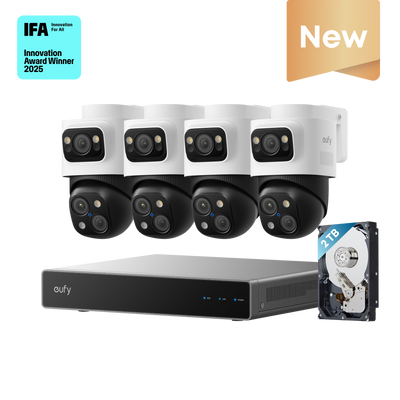UHD vs HD Guide: Main Differences
The debate over UHD vs HD continues as display technology advances, shaping how we watch, work, and secure our spaces. Whether you're upgrading your TV, projector, or security system, understanding these two resolutions helps you make smarter choices. This guide breaks down what sets UHD and HD apart, so you can decide which one best fits your viewing habits and everyday needs.

What is UHD vs HD?
Before exploring the differences, it's important to understand what each term means and how it shapes your viewing experience.
l Basics of HD
HD stands for High Definition. It offers a noticeable improvement over older standard definition screens by delivering sharper and clearer visuals.
A few common HD resolutions include:
1280 × 720 pixels (720p), often called HD.
1920 × 1080 pixels (1080p), also called Full HD or FHD.
In this setup, the first number represents horizontal pixels and the second indicates vertical pixels. HD remains a reliable choice for most everyday uses, such as watching cable TV, streaming, and gaming, especially on smaller screens.
l Basics of UHD
UHD, or Ultra High Definition, typically refers to a resolution of 3840 × 2160 pixels (often called “4K UHD”).
Because UHD has four times as many pixels as HD, it can show much finer detail, making images crisper and more realistic, especially on large screens or when viewing close-up.
UHD vs HD: Main Differences
While both resolutions deliver high-quality visuals, UHD and HD differ in resolution, detail, and overall viewing experience.
Resolution
The most noticeable difference lies in pixel count. HD (1280 × 720 pixels) refers to standard high-definition video, while UHD or 4K (3840 × 2160 pixels) offers about nine times as many pixels as 720p HD and roughly four times as many as Full HD (1080p).
This higher pixel density allows UHD displays to show smoother edges and more lifelike detail, especially on large screens or when viewed up close.
Image Clarity and Detail
HD performs well on small to medium-sized screens, providing clear visuals for everyday viewing. However, as the display size increases, the image can appear less crisp.
UHD, on the other hand, maintains remarkable clarity across all screen sizes, ensuring that textures, edges, and fine details stay sharp for an immersive experience in movies, gaming, or streaming.
Color Depth and Contras
UHD displays often feature wider color gamuts and improved contrast ratios, creating richer and more dynamic images. You'll notice deeper blacks, brighter highlights, and more vibrant colors compared to standard HD screens. While HD still produces good color and brightness, it can't quite reach the same level of realism that UHD provides.
Content Availability and Compatibility
HD content remains common across broadcast TV and online platforms, making it widely accessible.
However, UHD has become the new standard for many modern productions. Streaming platforms, 4K Blu-ray movies, and next-generation gaming consoles all support UHD resolution, allowing users to make the most of higher-quality displays.
To make things clearer, here is the comparison chart between UHD and HD:
|
Aspect |
HD (High Definition) |
UHD (Ultra High Definition / 4K) |
|
Resolution |
1280 × 720 pixels (720p)/1920 × 1080 pixels (1080p) |
3840 × 2160 pixels (2160p) |
|
Pixel Count |
921,600 pixels/ 2,073,600 pixels |
8,294,400 pixels (≈9× more than 720p) |
|
Clarity |
Clear, good detail |
Exceptionally sharp, finer details |
|
Screen Size |
Ideal up to ~65 inches |
Best for large screens and projectors |
|
Viewing Experience |
Great for everyday viewing |
Superior realism; ideal for 4K movies and gaming |
|
Bandwidth |
Lower streaming bandwidth |
Higher bandwidth required |
|
File Size |
Smaller media files |
Larger files due to higher resolution |
|
Compatibility |
Works on most devices |
Needs UHD-capable TV or monitor |
|
Cost |
More affordable |
Higher cost for UHD displays and content |
UHD vs HD: How to Choose the Right Resolution for Your Needs
Selecting between UHD and HD depends on how you watch content, the type of device you use, and your personal preferences. The following sections explain how each resolution performs across different applications.
HD TV vs UHD TV
When comparing HD TV vs UHD TV, consider your screen size and how far you usually sit from it. For smaller screens under 40 inches, HD provides excellent clarity, and the difference from UHD may not be noticeable. It's a budget-friendly option that suits everyday viewing.
For larger displays, a UHD TV vs HD setup makes a visible difference. UHD TVs show more detail and depth, especially when you watch from a short distance. If you enjoy streaming movies, gaming, or sports, UHD delivers a more immersive experience and prepares your setup for the future as more 4K content becomes available.
UHD vs HD on Streaming Platforms
Streaming services offer content in both HD and UHD to cater to different users and internet capabilities. Understanding the distinctions helps you choose the right plan and setup for your home.
On most streaming platforms, UHD provides sharper images and finer details than HD. It enhances textures, color balance, and brightness. However, UHD requires a faster internet connection and a device that supports 4K playback. It also consumes more data, making a stable and high-speed network essential.
HD remains a practical choice if your internet connection is limited or if you mainly watch casual shows or smaller screens. UHD streaming shines when paired with high-end TVs, offering a more cinematic and lifelike experience.
UHD vs HD for Projectors
Resolution plays a major role in how projectors perform, particularly when it comes to display size and viewing distance.
If your screen measures below 40 inches, HD resolution provides a clear and balanced picture. The difference between HD and UHD is minimal at that size. For larger screens, UHD becomes the better option, producing sharper visuals and more realistic details that hold up across the full projection area.
Viewing distance also affects image quality. If you sit within six feet of your screen, UHD's finer pixel density makes a visible difference. From farther away, HD might be sufficient since the eye can't easily detect pixel variations.
Finally, consider your viewing preferences. If you enjoy UHD movies, HDR visuals, or gaming, a UHD projector is the superior choice. But for casual viewing or presentations with HD content, an HD projector remains a cost-effective solution.
UHD vs HD for Movies
Resolution dramatically impacts the cinematic experience. UHD movies, often referred to as 4K, feature a resolution of 3840x2160 pixels, bringing more lifelike detail and greater depth to every frame. The higher pixel count enhances textures, lighting, and color balance, making scenes appear almost tangible.
HD movies, typically at 1920x1080 pixels, still offer good quality but lack the richness and detail of UHD. If you have a compatible device and sufficient bandwidth, UHD delivers a more immersive, theater-like experience. However, HD remains a dependable choice for viewers with smaller screens or limited internet speeds.
UHD vs HD in Surveillance
Beyond entertainment, resolution plays a crucial role in home and business security. The difference between UHD and HD in surveillance impacts how well cameras capture detail, identify faces, and record incidents.
An HD security camera captures video at resolutions like 720p or 1080p, offering reliable clarity for general monitoring. HD systems are easy to install and are ideal for smaller spaces or entry-level security setups. They provide essential coverage with decent detail, sufficient for detecting movement or recognizing familiar faces.
UHD cameras, on the other hand, record in 4K resolution (3840×2160 pixels). A 4K wireless security camera delivers the same high-resolution performance with added installation flexibility, making it ideal for homes and small businesses. This results in clearer, more detailed images that make identifying objects and individuals easier. UHD systems also offer better digital zooming without losing image quality, an advantage when reviewing footage or monitoring large areas.
For example, the eufy PoE NVR Security System S4 Max delivers exceptional UHD surveillance performance. Its 16 MP triple-lens camera combines a 4K wide-angle lens with a 2K PTZ lens for complete coverage. The system's live cross-cam tracking and AI-powered analysis ensure consistent, accurate monitoring in real time—ideal for large properties needing UHD-level precision.

Similarly, the eufy PoE NVR Security System S4 offers a blend of UHD detail and intelligent coverage. With multiple 4K and 2K PTZ cameras working together, it captures both fixed and dynamic scenes effortlessly. The system's local AI agent distinguishes real threats, while its weatherproof design ensures reliability in various outdoor environments.

For a flexible, solar-powered option, the eufyCam S4 provides UHD-level clarity with dual-lens tracking. Its 4K bullet camera monitors wide areas, while the 2K PTZ lens follows movement in real time. Equipped with SolarPlus™ charging and advanced night vision, it delivers around-the-clock UHD security without constant recharging—perfect for homeowners seeking effortless protection.

alt:
Conclusion
The choice between UHD vs HD depends on your goals, space, and viewing habits. UHD delivers outstanding clarity, color depth, and realism, making it ideal for larger screens and modern content. HD, however, remains reliable for smaller displays, everyday streaming, and simple setups. Both have their place—what matters is choosing the one that matches your needs and gives you the best viewing experience for your investment.
FAQs
Can I watch UHD on my HD TV?
You can play UHD content on an HD TV, but it won't display in true 4K quality. The TV will automatically downscale the video to match its HD resolution. While you can still watch the content, you'll miss the extra sharpness, detail, and color depth that a UHD screen can provide.
What does UHD mean on Amazon Prime?
On Amazon Prime, UHD means “Ultra High Definition,” also known as 4K. It refers to shows or movies with a resolution of 3840x2160 pixels. UHD offers sharper images, richer colors, and more detail compared to HD. However, to stream UHD on Prime, you need a compatible 4K TV, a strong internet connection, and the correct streaming plan.
Which is better, HD or UHD?
UHD is better than HD in terms of image quality, detail, and color accuracy. With four times more pixels than HD, UHD delivers clearer and more lifelike visuals, especially on large screens. However, HD is still a solid choice for smaller TVs or when internet bandwidth is limited, as it requires less data and streaming speed.
How do I know if my TV is HD or UHD?
Check your TV's resolution settings or manual. If it lists 1920x1080 pixels, it's an HD TV. If it shows 3840x2160 pixels or mentions 4K, it's a UHD TV. You can also look for labels like “Full HD” or “Ultra HD” on the box or TV menu. UHD models often advertise 4K or HDR capabilities on the packaging.















